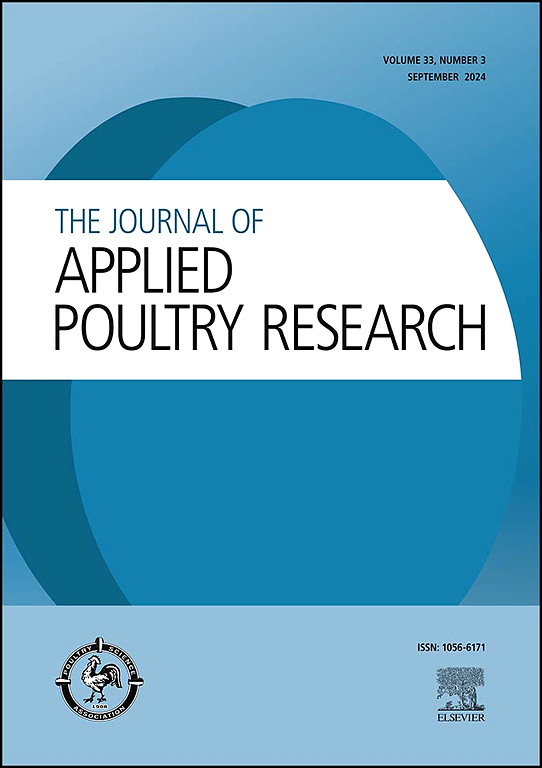应用研究说明:使用二维成像系统预测纯种火鸡(Meleagris gallopavo)系的胴体部分重量
IF 2
3区 农林科学
Q2 AGRICULTURE, DAIRY & ANIMAL SCIENCE
引用次数: 0
摘要
提高胴体部分产量(如胸肉)是现代火鸡养殖的主要目标,传统上需要人工收集部分重量。考虑到育种公司需要大量有用的数据,这可能是一个劳动密集型的过程。最近,人们对使用计算机视觉系统来评估家禽肉的尺寸、重量、体积和等级等参数越来越感兴趣。目前的研究利用非侵入性实时二维胴体成像系统开发了数学方程来预测火鸡(4000)的肉产量。虽然我们的胸肉模型被证明是好的,但大腿和鼓模型并没有显示出观察到的和预测的重量之间的高度相关性,这可能是由于图像的方向和图像捕获过程中产生的任何潜在的变化。这些结果代表了使用实用成像系统开发有价值的火鸡胴体部分预测模型的第一步。需要进行进一步的调查,以证明该系统比简单地预测活重的部分重量更有效,并帮助业界以经济有效的方式更好地收集表型。本文章由计算机程序翻译,如有差异,请以英文原文为准。
Applied research note: Predicting carcass portion weights for purebred turkey (Meleagris gallopavo) lines using a 2D imaging system
Improving carcass portion yields (e.g., breast meat) is a major goal of modern turkey breeding and traditionally requires manual collection of portion weights. This can be a labor-intensive process considering the large amount of data needed to be useful for breeding companies. Recently, there has been increasing interest in using computer vision systems to assess parameters such as size, weight, volume, and grade of poultry meat. The present study developed mathematical equations to predict turkeys’ (4,000) meat yield using a non-invasive real-time 2D carcass imaging system. Although our breast meat models proved to be good, the thigh and drum models did not demonstrate a high correlation between observed and predicted weights probably due to the orientation of the image and any potential shifts made during image capture. These results represent a first step in developing prediction models for valuable turkey carcass portions using practical imaging systems. Further investigations need to take place to demonstrate this system can be more fruitful than simply predicting portion weight off live weight and help the industry to better collect phenotypes in a cost-effective manner.
求助全文
通过发布文献求助,成功后即可免费获取论文全文。
去求助
来源期刊

Journal of Applied Poultry Research
农林科学-奶制品与动物科学
CiteScore
4.10
自引率
10.50%
发文量
80
审稿时长
104 days
期刊介绍:
The Journal of Applied Poultry Research (JAPR) publishes original research reports, field reports, and reviews on breeding, hatching, health and disease, layer management, meat bird processing and products, meat bird management, microbiology, food safety, nutrition, environment, sanitation, welfare, and economics. As of January 2020, JAPR will become an Open Access journal with no subscription charges, meaning authors who publish here can make their research immediately, permanently, and freely accessible worldwide while retaining copyright to their work. Papers submitted for publication after October 1, 2019 will be published as Open Access papers.
The readers of JAPR are in education, extension, industry, and government, including research, teaching, administration, veterinary medicine, management, production, quality assurance, product development, and technical services. Nutritionists, breeder flock supervisors, production managers, microbiologists, laboratory personnel, food safety and sanitation managers, poultry processing managers, feed manufacturers, and egg producers use JAPR to keep up with current applied poultry research.
 求助内容:
求助内容: 应助结果提醒方式:
应助结果提醒方式:


